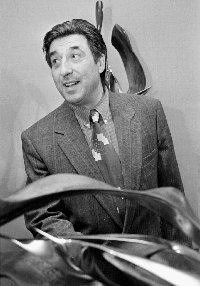Yevhen PROKOPOV:"I know thatthe best critics are at home"

Colleagues treat Yevhen Prokopov with something akin to reverence. Regrettably, few other Ukrainian artists can boast of having their works displayed by European and North American galleries. The Day asked the sculptor for an interview published below.
Q: The new works on display are very different from your previous figurative exhibits, particularly the excellent ballerina series of the 1980s. Why?
A: I did them practically overnight but it took me a very long time to conceive each image. The previous exhibit, which I consider nonetheless important, was held at the Ukrainian House in 1994. It showed quite a number of figurative works and I think I overdid it. This time I tried to convey the feeling of space and quiet and I believe that abstract forms best suit this concept.
In America, we lived on an island with the shore covered by thousands of shellfish washed up by the ocean. I collected a lot of them, picking only shell fragments polished by water. Every coil secretes some primordial idea of construction. One is aware of the presence of some superior logic. I use such organic forms, adding more rigid, factual elements. The result is something irrational, providing limitless variation opportunities.
Q: Switching from figurative to designer patterns isn't easy, is it?
A: You're right. I held myself in check for a long time, knowing full well that narrative figurative plasticity looks very outdated at the end of the twentieth century. I did not want to force a change for a different sculptural language. It took me ten to fifteen years to get rid of everything taught by the academic school. Previously I was often criticized for what they called a literary approach. Now I try to remain perfectly laconic, and I think that what I am doing now is pure sculpture, without any narrative elements. I reached this stage through African sculpture and the works of Henry Moore. One has to make the entire history of culture felt in a most modern form, not just an empty avant-garde abstraction. Very many sculptors try to adapt their works to modern trends, but I will always tell a Moore from any imitation. The man in the street will regard both as just pieces of clay, but a real Moore always has its mystery of composition, whereas an epigone does it mechanically.
Q: Your works are quite popular in Europe and the United States. How do you benefit from those exhibits? Are they interested in Ukrainian art?
A: In the late 1980s when I started exhibiting my works there most gallery owners had no idea where Ukraine was located and my personal observations show that they are not very interested in folk art.
In America I was amazed to discover that culture is simply nonexistent to 99% of the populace. They want every work of art to imitate reality, that's all. Be it gypsum or plywood, it must look like Venus de Milo or an Italian palace. However, there is a group of very rich individuals across the world who are quite fond of and collecting modern art. And they come to America, because it is the center of modern art and it has the best museums. It is also an amazing architectural-plastic urban medium, a fantastic opportunity for the sculptor who can "implant" his own projects here. Such projects are financed not by the state but by private firms, charitable foundations, and large museums.
Q: What about your Kyiv exhibits, considering that here you have no such opportunities?
A: I am Ukrainian, this is my native land. I live and work in
my studio here. Abroad I display works made in Kyiv. This is quite expensive,
but I can't do it any other way. I was born here, emerging from this environment,
from contacts with talented sculptors whose opinion I hold dear. I know
that the best critics are at home, because we are more frank with each
other. And more demanding. They will say, "This isn't bad, but..." and
then crucify you. They praise you in Europe and America, but their critics
mostly share their own views and emotions. Besides, I don't want to be
forgotten here, which makes this exhibit especially important; it shows
my attempt to use designer principles in an elegant presentation.
Newspaper output №:
№40, (1998)Section
Culture





